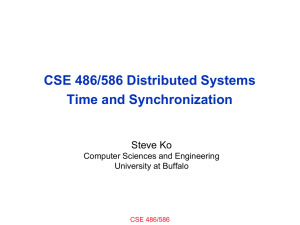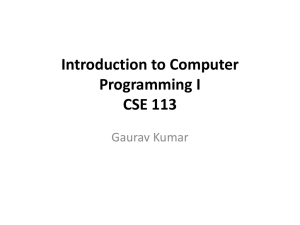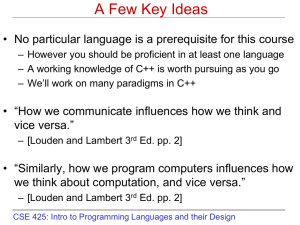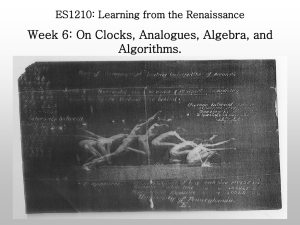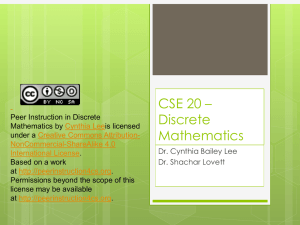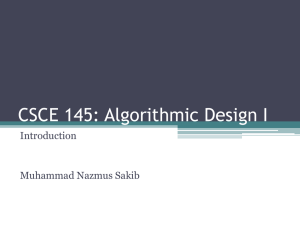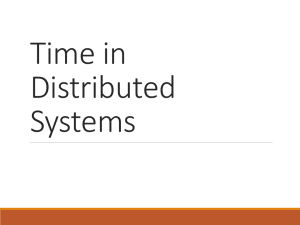pptx - Computer Science and Engineering
advertisement
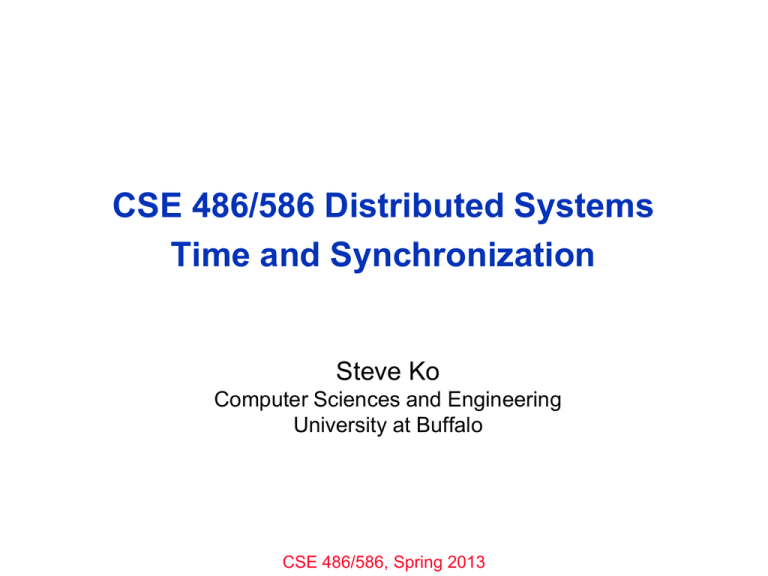
CSE 486/586 Distributed Systems Time and Synchronization Steve Ko Computer Sciences and Engineering University at Buffalo CSE 486/586, Spring 2013 Last Time • Models of Distributed Systems – Synchronous systems – Asynchronous systems • Failure detectors---why? – Because things do fail. • Failure detectors---what? – Properties: completeness & accuracy – Metrics: bandwidth, detection time, scale, accuracy • Failure detectors---how? – Two processes: Heartbeating and Ping – Multiple processes: Centralized, ring, all-to-all CSE 486/586, Spring 2013 2 Today’s Question • Servers in the cloud need to timestamp events • Server A and server B in the cloud have different clock values – – – – You buy an airline ticket online via the cloud It’s the last airline ticket available on that flight Server A timestamps your purchase at 9h:15m:32.45s What if someone else also bought the last ticket (via server B) at 9h:20m:22.76s? – What if Server A was > 10 minutes ahead of server B? Behind? – How would you know what the difference was at those times? CSE 486/586, Spring 2013 3 Physical Clocks & Synchronization • Some definitions: Clock Skew versus Drift • Clock Skew = Relative Difference in clock values of two processes • Clock Drift = Relative Difference in clock frequencies (rates) of two processes • A non-zero clock drift will cause skew to continuously increase. • Real-life examples – Ever had “make: warning: Clock skew detected. Your build may be incomplete.”? – It’s reported that in the worst case, there’s 1 sec/day drift in modern HW. – Almost all physical clocks experience this. CSE 486/586, Spring 2013 4 Synchronizing Physical Clocks • Ci(t): the reading of the software clock at process i when the real time is t. • External synchronization: For a synchronization bound D>0, and for source S of UTC time, S (t ) Ci (t ) D, for i=1,2,...,N and for all real times t. Clocks Ci are accurate to within the bound D. • Internal synchronization: For a synchronization bound D>0, Ci (t ) C j (t ) D for i, j=1,2,...,N and for all real times t. Clocks Ci agree within the bound D. • External synchronization with D Internal synchronization with 2D • Internal synchronization with D External synchronization with ?? CSE 486/586, Spring 2013 5 Clock Synchronization Using a Time Server mr mt p Time server,S CSE 486/586, Spring 2013 6 Cristian’s Algorithm: External Sync • Uses a time server to synchronize clocks • Mainly designed for LAN • Time server keeps the reference time (say UTC) • A client asks the time server for time, the server responds with its current time, and the client uses the received value T to set its clock • But network round-trip time introduces an error. • So what do we need to do? – Estimate one-way delay CSE 486/586, Spring 2013 7 Cristian’s Algorithm • Let RTT = response-received-time – request-senttime (measurable at client) • Also, suppose we know – The minimum value min of the client-server one-way transmission time [Depends on what?] – That the server timestamped the message at the last possible instant before sending it back • Then, the actual time could be between [T+min,T+RTT— min] min T RTT Request sent CSE 486/586, Spring 2013 min Response received 8 Cristian’s Algorithm • (From the previous slide), the accuracy is: +-(RTT/2 – min) • Cristian’s algorithm – A client asks its time server. – The time server sends its time T. – The client estimates the one-way delay and sets its time. » It uses T + RTT/2 • Want to improve accuracy? – Take multiple readings and use the minimum RTT tighter bound – For unusually long RTTs, ignore them and repeat the request removing outliers CSE 486/586, Spring 2013 9 Berkeley Algorithm: Internal Sync • Uses an elected master process to synchronize among clients, without the presence of a time server • The elected master broadcasts to all machines requesting for their time and adjusts times received for RTT & latency, averages times • The master tells each machine the difference. • Issues • Averaging client’s clocks may cause the entire system to drift away from UTC over time • Failure of the master requires some time for re-election, so accuracy cannot be guaranteed CSE 486/586, Spring 2013 10 CSE 486/586 Administrivia • How was the assignment? • PA2 will be out soon. • Please read the Android docs. – OnClickListener, OnKeyListener, AsyncTask, Thread, Socket, etc. • Please understand the flow of PA1. • Please be careful about your coding style. • Lecture slides – I will try posting them a day before. – I will also post a PDF version. • There is a course website. – Schedule, syllabus, readings, etc. CSE 486/586, Spring 2013 11 The Network Time Protocol (NTP) • Uses a network of time servers to synchronize all processes on a network. • Designed for the Internet • Why not Christian’s algo.? • Time servers are connected by a synchronization subnet tree. The root is in touch with UTC. Each node synchronizes its children nodes. • Why? Primary server, direct sync. 1 Secondry servers, sync’ed by the primary server 2 2 3 3 3 2 3 3 CSE 486/586, Spring 2013 3 Strata 3, sync’ed by the secondary servers 12 Messages Exchanged Between a Pair of NTP Peers (“Connected Servers”) Server B Ti-2 m Ti-1 Time m' Time Server A Ti- 3 Ti Each message bears timestamps of recent message events: the local time when the previous NTP message was sent and received, and the local time when the current message was transmitted. CSE 486/586, Spring 2013 13 Theoretical Base for NTP Server B Ti-2 m Ti-1 Time m' Time Server A Ti- 3 Ti • oi: estimate of the actual offset between the two clocks • di: estimate of accuracy of oi ; total transmission times for m and m’; di=t+t’ • For better accuracy, – One NTP server talks to many other peers. – Each NTP server applies a data filtering algorithm. – Then keeps the 8 most recent pairs of <oi, di>, and selects the minimum di CSE 486/586, Spring 2013 14 Theoretical Base for NTP Server B Ti-2 Ti-1 Time m m' (with delay t) (with delay t’) Time Server A Ti- 3 Ti First, let's get o : T i-2 = T i-3 + t + o T i = T i-1 + t' -o Þ o = (T i-2 - T i-3 + T i-1 - T i) /2 + (t' -t) /2 Then, get the bound for (t' -t) /2 : Finally, we set : o i = (T i-2 - T i-3 + T i-1 - T i) /2 d i = t + t' = T i-2 - T i-3 + T i - T i-1 Then we get : o i - d i /2 £ o £ o i + d i /2. -t' -t £ t' -t £ t'+t (since t',t ³ 0) CSE 486/586, Spring 2013 15 Then a Breakthrough… • We cannot sync multiple clocks perfectly. • Thus, if we want to order events happened at different processes (remember the ticket reservation example?), we cannot rely on physical clocks. • Then came logical time. – First proposed by Leslie Lamport in the 70’s – Based on causality of events – Defined relative time, not absolute time • Critical observation: time (ordering) only matters if two or more processes interact, i.e., send/receive messages. CSE 486/586, Spring 2013 16 Events Occurring at Three Processes p1 a b m1 Phy s ic al ti me p2 c d m2 p3 e f CSE 486/586, Spring 2013 17 Summary • Time synchronization important for distributed systems – Cristian’s algorithm – Berkeley algorithm – NTP • Relative order of events enough for practical purposes – Lamport’s logical clocks • Next: continue on logical clocks and the global system state CSE 486/586, Spring 2013 18 Acknowledgements • These slides contain material developed and copyrighted by Indranil Gupta at UIUC. CSE 486/586, Spring 2013 19

